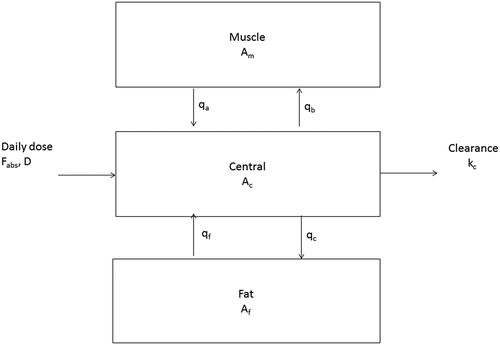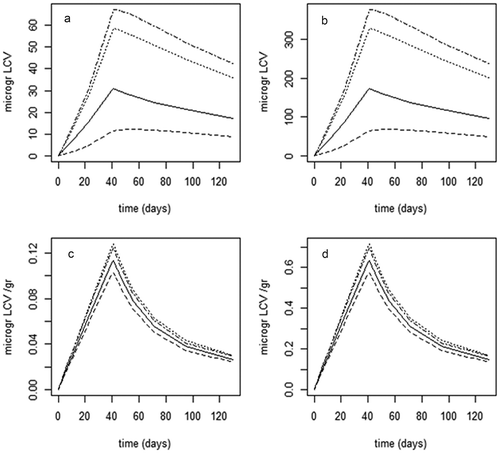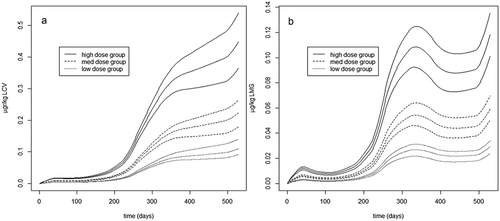Figures & data
Figure 1. Schematic representation of a physiological-based kinetic (PBK) model for the disposition of leuco crystal violet and leuco malachite green in the muscle of adult consumption-sized Atlantic salmon (Salmo salar), using a three-compartmental approach. ‘A’ denotes the amount of contaminant in a compartment (muscle: Am, central: Ac and fat: Af). Fraction F of the dose is absorbed (Fabs, D) over the gut wall into the central compartment. Kc represents the elimination through clearance. Qb and qc represent the compartmental transfer parameters from central to muscle (qb → qcm) and fat compartments (qc → qcf), respectively, while qa and qf, respectively, represent the transfer from the muscle (qa → qmc) and fat compartments (qf → qfc) to the central compartment.

Figure 2. The body composition in percentage of total weight of a whole fish. As an example, relative volumes are given of an approximately 1 kg Atlantic salmon. For a three-compartmental model approach, the whole fish can be divided into a central (29%), muscle (58%) and fat compartment (13%). The central compartment can be divided into organs such as liver, kidney, gills, etc. The muscle compartment in total is part of the fillet. The fat compartment in which LCV and LMG will accumulate can be divided into a fillet part (fillet fat 8%) and fat located outside the fillet such as abdominal fat and bone marrow fat (‘remaining fat’ 5%). The accumulation of LCV and LMG in fillet is described as the separate accumulation in the muscle and fat compartments of the fillet.

Figure 3. (a–d) Fillet concentrations (µg kg−1 WW) in Atlantic salmon fed two levels of LCV (0.86 and 4.8 mg kg−1, a and b, respectively) and LMG (0.77 and 4.7 mg kg−1, c and d, respectively) for 40 days, followed by a 90-day depuration (mean ± SD, n = 2 of 5 pooled fish samples per time point, at day 40, n = 10 from 10 individual fish samples).

Figure 4. (a–d) Measured concentration amount (µg kg−1, data points consist of two pooled samples from five fish per time point, at day = 40 data points consists of 10 individual fish samples) of leuco crystal violet (LCV) and leuco malachite green (LMG) in the fillet of Atlantic salmon fed two levels of LCV (0.86 and 4.8 mg kg−1, a and b, respectively) and LMG (0.77 and 4.7 mg kg−1, c and d, respectively) for 40 days, followed by a 90-day depuration, and period model-simulated concentration–time curve based on fitted parameters. Model simulation is even line (results) and measured values (data) are data points with broken line.

Figure 5. (a–d) Model predicted total amount (µg) of leuco crystal violet (LCV) and leuco malachite green (LMG) in the fillet of Atlantic salmon fed two levels of LCV (0.86 and 4.8 mg kg−1, a and b, respectively) and LMG (0.77 and 4.7 mg kg−1, c and d, respectively) for 40 days, followed by a 90-day depuration, and period model-simulated concentration–time curve based on fitted parameters. Model-simulated amounts in fillet are given as uneven line (–.–.), model predictions for muscle part of the fillet as broken line (.......), model predictions for the fat part of the fillet as dashed line (–––) and central compartment as straight line (——). For the definition of fillet fat and filet muscle, see .

Figure 6. (a, b)Model-simulated concentration of (µg kg−1 ww) leuco crystal violet (LCV) (a) and leuco malachite green (LMG) (b) over time in the fillet of Atlantic salmon farmed under realistic conditions during a full seawater production cycle with either a high feed level (1.1 µg kg−1; even line), medium feed level (0.55 µg kg−1; dashed line) or a low feed level (0.28 µg kg−1; broken line). Predictions are given as medium estimated levels (middle curve per feed level group) as well as 95% confidence intervals (upper and lower curve per feed group).

